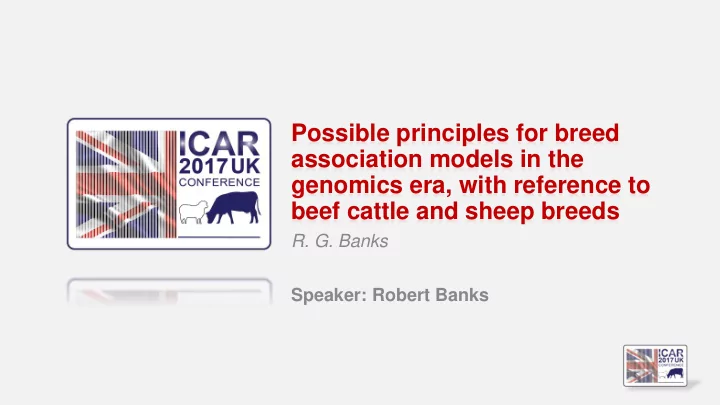

Possible principles for breed association models in the genomics era, with reference to beef cattle and sheep breeds R. G. Banks Speaker: Robert Banks
Possible principles for breed association models in the genomics era, with reference to beef cattle and sheep breeds Rob Banks Director, AGBU rbanks@une.edu.au AGBU 2017
The future for breed associations, societies • Is as R&D organisations, aiming to: – Maximise r. δ $ per funds invested for some defined gene pool – Maximise ir/L • This will require: – New forms of association – New pricing and rewarding models – Likely long-term partnerships with others in the value chain (either private and/or public)
Perspectives, within and between countries: • Within- country “rules”: – Have to be equitable and efficient – Must have well-designed incentives/rewards, and minimise free-riding • Between-country: – Sharing data is almost invariably a win-win (benefit may be small, but cannot be negative) – Shared or coordinated design – young sire sampling, designed phenotyping and genotyping – will increase value – Estimating r g between countries for objectives and for traits should be core activities – These are true irrespective of whether there is one evaluation or many • Are these consistent? – Do “breeds” need to work as global partnerships or networks to survive?
Summary: • Genomic selection is a radical innovation (breaks the nexus between records and EBVs) • But it requires radical organisational innovation to obtain benefits: – New models for coordinated breeding program design – New partnerships to achieve those new models • ideally whole chain – Focus on creation of information and harvesting its value, not on dragging breeders into new technology – As always, effective cooperation can generate greatest long- term benefits – We need clever thinking and R&D
A (bad) example - the Australian energy market • Sources of energy: – Coal-fired – Natural gas (on- and off-shore) – Hydro-electric – Wind – solar • Rapid change in relative properties of sources – Cost – reliability • “market” is a mix of state and private entities, with a regulator • Chronic problems of over-investment in some components (poles and lines), coupled with extremely inefficient signalling & rules, and apparently limited appreciation of scope for gaming ie network architecture
Breed associations: • Some core services (database, staff, analysis) • Multiple diverse members: – Differ in behaviours (recording, selection, marketing) • Recording effort seems to be repeatable • Selection effort not repeatable – Differ in contribution (a power law distribution) • Incentives – internal and external sales • Externalities – Exist with P and pedigree – Exponentially more with genomics • Rules and decision-making – around purity and charges • Is there a reason to care?
Key challenges: • Managing variation, not imposing conformity – Maximal variation in animals is ideal • Meeting customer expectations – Minimal variation is ideal • Aggregating diverse data to produce information – Different data has different value • Core costs are unchanged, so you have data + core processing gives rise to EBVs (etc) which give rise to selection and multiplication – Data + process information decisions (selection, multiplication) – v(data) v(information) v(selection)
Simple case: • 1 reference population (n = 1,000), where all recording takes place • A breeding nucleus (n = 10,000) which produces bulls, which breed commercial progeny (n = 360,000) • Divide total reference population cost across bulls, heifers, and commercial progeny • Should we charge more for tests on bulls and heifers because they have more expressions? – c. 44 expressions per nucleus bull or heifer – 1 expression per commercial animal • Charging too much or too little will cause distortions • Can differential charging work? – If reference costs $1m pa, royalty for nucleus animals = $55, and for commercial = $1
Real life: • Reference population: – Some defined collective investment in HTM traits – Some variable investment by individuals in other traits • Costs in total: – HTM traits – Other traits, variable investment per animal (and per breeder) – Core database and analysis, and other overheads – genotyping • Recouping costs, principles are the same as for the simple case • So, should system recognise variation in “other trait” recording?
Pros and cons: • If market already rewards genetic superiority, is there a risk of double counting? • Reward function needs to: – Be non-linear (because returns are not unlimited, and oversubscription will bankrupt you) – Reflect overall return for investment ie the regression of reward on increment of objective accuracy must be the right level • What about generating optimal recording and mating sets, and “penalising” deviations
Two “easy” solutions: • Completely rule-defined, allowing no variation: – More cost to implement (who pays?) – Needs very strong belief in the rules, and ultimate success – Who sets the rules? • Completely market-based – Very easy (“the market decides”) – Implementation risk is minimised – Outcome risk is maximised • Neither is ideal
Principles: • Phenotypes vary in quality, or value – this needs to be recognised, ideally at the point or time of that decision • Variation in selection (direction, rate) affect both the individual and the breed – needs to be minimised • Mechanism for “payment” – Cash is impossible for most organisations – Waiving royalties, and/or providing advice is more feasible • Would point of decision apps help shift all decisions towards optima? • Rewards or incentives must have limits, and are likely to reinforce any market rewards – risk of emigration
Recommend
More recommend